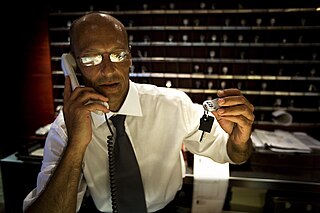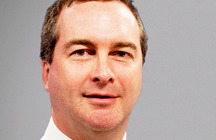
Government Communications Headquarters (GCHQ) is an intelligence and security organisation responsible for providing signals intelligence (SIGINT) and information assurance (IA) to the government and armed forces of the United Kingdom. Primarily based at "The Doughnut" in the suburbs of Cheltenham, GCHQ is the responsibility of the country's Secretary of State for Foreign and Commonwealth Affairs, but it is not a part of the Foreign Office and its Director ranks as a Permanent Secretary.

A concierge is an employee of a multi-tenant building, such as a hotel or apartment building, who receives guests. The concept has been applied more generally to other hospitality settings and to personal concierges who manage the errands of private clients.

Sir Francis Neville Richards is a former British civil servant and diplomat who was Governor and Commander-in-Chief of Gibraltar from 2003 to 2006, and the director of the Government Communications Headquarters from 1998 to 2003.

GCHQ Bude, also known as GCHQ Composite Signals Organisation Station Morwenstow, abbreviated to GCHQ CSO Morwenstow, is a UK Government satellite ground station and eavesdropping centre located on the north Cornwall coast at Cleave Camp, between the small villages of Morwenstow and Coombe. It is operated by the British signals intelligence service, officially known as the Government Communications Headquarters, commonly abbreviated GCHQ. It is located on part of the site of the former World War II airfield, RAF Cleave.

The Intelligence Services Act 1994 is an Act of the Parliament of the United Kingdom.

The Five Eyes (FVEY) is an Anglosphere intelligence alliance comprising Australia, Canada, New Zealand, the United Kingdom, and the United States. These countries are parties to the multilateral UK-USA Agreement, a treaty for joint cooperation in signals intelligence. Informally, Five Eyes can also refer to the group of intelligence agencies of these countries.
Geoffrey Arthur Prime is a former British spy who worked for the Royal Air Force as well as the Government Communications Headquarters (GCHQ). While working for these organizations, Prime disclosed information to the Soviet Union. He was convicted in the early 1980s under charges of espionage and child sexual abuse. He was sentenced to a total of 38 years imprisonment, but he was released from prison in 2001.
Ralph Benjamin was a British scientist and electrical engineer.
Mastering the Internet (MTI) is a mass surveillance project led by the British communications intelligence agency Government Communications Headquarters (GCHQ) budgeted at over £1 billion. According to reports in The Register and The Sunday Times in early May 2009, contracts with a total value of £200m had already been awarded to suppliers.

Robert Peter Hannigan CMG is a cybersecurity specialist who has been Warden of Wadham College, Oxford, since 2021. He was a senior British civil servant who previously served as the director of the signals intelligence and cryptography agency the Government Communications Headquarters (GCHQ) and established the UK's National Cyber Security Centre. His sudden resignation as director was announced on 23 January 2017, and he stepped down at the end of April 2017 to pursue a career in private sector cyber security, academia and as a security commentator. In 2021 he became Warden of Wadham College, Oxford.
Sir Charles Blandford Farr was a British civil servant, intelligence officer, and diplomat. He was Chairman of the Joint Intelligence Committee and Head of the Joint Intelligence Organisation at the Cabinet Office until his death in February 2019. Before that, from 2007 until 2015 Farr was the Director of the Office for Security and Counter-Terrorism (OSCT) at the United Kingdom's Home Office.

Tempora is the codeword for a formerly-secret computer system that is used by the British Government Communications Headquarters (GCHQ). This system is used to buffer most Internet communications that are extracted from fibre-optic cables, so these can be processed and searched at a later time. It was tested from 2008 and became operational in late 2011.

The use of electronic surveillance by the United Kingdom grew from the development of signal intelligence and pioneering code breaking during World War II. In the post-war period, the Government Communications Headquarters (GCHQ) was formed and participated in programmes such as the Five Eyes collaboration of English-speaking nations. This focused on intercepting electronic communications, with substantial increases in surveillance capabilities over time. A series of media reports in 2013 revealed bulk collection and surveillance capabilities, including collection and sharing collaborations between GCHQ and the United States' National Security Agency. These were commonly described by the media and civil liberties groups as mass surveillance. Similar capabilities exist in other countries, including western European countries.
John Kane was a Scottish whistleblower who was prevented from publishing two books alleging corruption at the British intelligence agency Government Communications Headquarters (GCHQ). Kane served with the Royal Air Force in various European theatres as a radio operator in World War II, before joining GCHQ after the war. While serving with GCHQ in Hong Kong, Kane was concerned with the lack of security and after uncovering fraud, raised his complaints with officials. Kane retired in 1978 and his complaints were investigated by a senior civil servant, but the report was never published. Kane wrote a memoir in 1984, GCHQ: The Negative Asset, which was subsequently banned, as was a second memoir, The Hidden Depths of Treachery. Kane later worked as a school bus driver after retiring from GCHQ.

Ongoing news reports in the international media have revealed operational details about the Anglophone cryptographic agencies' global surveillance of both foreign and domestic nationals. The reports mostly emanate from a cache of top secret documents leaked by ex-NSA contractor Edward Snowden, which he obtained whilst working for Booz Allen Hamilton, one of the largest contractors for defense and intelligence in the United States. In addition to a trove of U.S. federal documents, Snowden's cache reportedly contains thousands of Australian, British, Canadian and New Zealand intelligence files that he had accessed via the exclusive "Five Eyes" network. In June 2013, the first of Snowden's documents were published simultaneously by The Washington Post and The Guardian, attracting considerable public attention. The disclosure continued throughout 2013, and a small portion of the estimated full cache of documents was later published by other media outlets worldwide, most notably The New York Times, the Canadian Broadcasting Corporation, the Australian Broadcasting Corporation, Der Spiegel (Germany), O Globo (Brazil), Le Monde (France), L'espresso (Italy), NRC Handelsblad, Dagbladet (Norway), El País (Spain), and Sveriges Television (Sweden).

Global mass surveillance can be defined as the mass surveillance of entire populations across national borders.

The Doughnut is the nickname given to the headquarters of the Government Communications Headquarters (GCHQ), a British cryptography and intelligence agency. It is located on a 71 hectares site in Benhall, in the suburbs of Cheltenham, Gloucestershire, in South West England. The Doughnut accommodates 5,500 employees; GCHQ is the largest single employer in Gloucestershire. Built to modernise and consolidate GCHQ's multiple buildings in Cheltenham, the Doughnut was completed in 2003, with GCHQ staff moving in the same year, and fully moved into the building in 2004. It is the largest building constructed for secret intelligence operations outside the United States.

This timeline of global surveillance disclosures from 2013 to the present day is a chronological list of the global surveillance disclosures that began in 2013. The disclosures have been largely instigated by revelations from the former American National Security Agency contractor Edward Snowden.

The Admiralty Civilian Shore Wireless Service (ACSWS) was a radio service and network of wireless stations operated by the British Royal Navy based at Irton Moor, Scarborough, North Yorkshire, England from 1939 to 1956.











